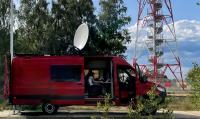Staying connected under extreme conditions
Researches from the Faculty of Electronics and Information Technology have developed a prototype of the Mobile Distribution Point of ICT Infrastructure (MPDIT). It is a dedicated vehicle that will be essential in the work of services wherever a critical situation may potentially take place or has already occurred. This includes natural disasters, floods, fires, mass events, large search parties, or even terrorist attacks.
From the outside, MPDIT looks like a typical bus. However, inside there is highly specialized equipment that enables communication in all conditions, integrates various means of communication - digital communication (sound, image, data stream), and manages them. This allows for efficient planning and command of a rescue operation, in particular for commanding patrols operating in difficult and extensive terrain.
Useful functionalities
– The innovative teleinformation solutions we applied, allow, above all, to maintain the structure of local communication without external power sources – explains Grzegorz Kasprowicz, PhD, the system constructor. – In times of natural disasters, when the mobile network goes out of service, it is particularly important. Moreover, the technology we have developed is not only limited to signal transmission, but also their integration and interpretation.
This means that not only can one receive an image, e.g. transmitted by foot patrols, but also automate the process of sending directly to the OST 112 alert network (Polish Nationwide Teleinformation Network). You can also use information, e.g. from police databases about wanted or dangerous people.
MPDIT has a number of useful functionalities: instant establishment of a uniform Wi-Fi network, the ability to transmit content in the form of audio and video streams, fast PTT (Push To Talk) communication, visualization of the location of communication points, the ability to choose a device with GSM, Wi-Fi, or without it, the use of analog VHF/UHF (radiotelephones) and digital DMR / TETRA (radio communication) systems and integration with the access node of OST 112 (Polish Nationwide Teleinformation Network) – a nationwide teleinformatic network that is the basis of the Emergency Notification System.
A system tailored to your needs
– Our solutions are characterized by a modular structure - adds Kasprowicz, PhD – This enables any teletechnical configuration, and thus quick adjustment of equipment and communication channels to any needs. Other solutions are expected from policemen searching for a missing person, other from firefighters fighting fires, and still different from those managing public service forces while protecting and securing mass events.
Although the proposed solution is prepared in the form of a technology demonstrator (prototype), soon, thanks to close cooperation, e.g. with the Polish police, it could be used in real conditions.
Currently, field tests of the vehicle are being conducted based on various service scenarios.
Infrastructure (Mobilny Punkt Dystrybucyjny Infrastruktury Teleinformatycznej) (MPDIT)" project co-financed by the National Center for Research and Development as part of the 2018 Security and Defence BiO9 competition.
Consortium: Warsaw University of Technology (leader), Police Academy in Szczytno, Vortex Sp. z o.o. (limited liability company) and Longevity
Project manager: Krzysztof Poźniak, PhD, D.Sc. Prof. El. Eng., Institute of Electronic Systems from the Faculty of Electronics and Information Technology
Duration of the project: 2018-2021








